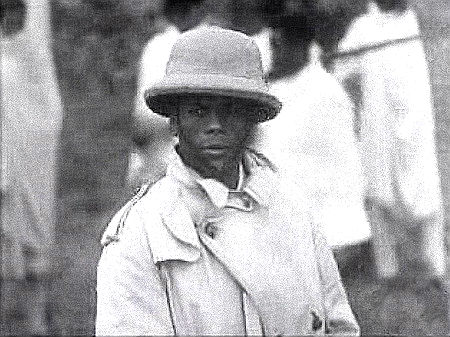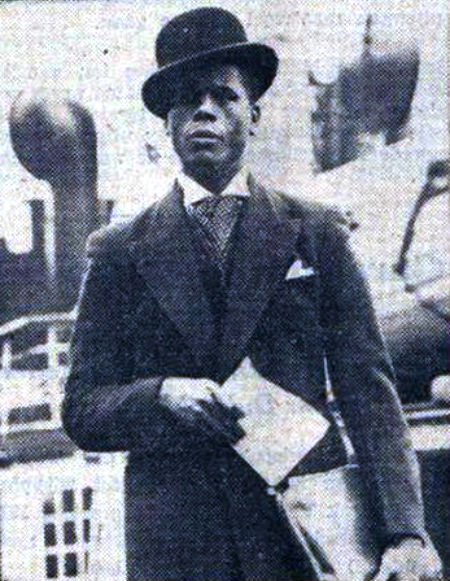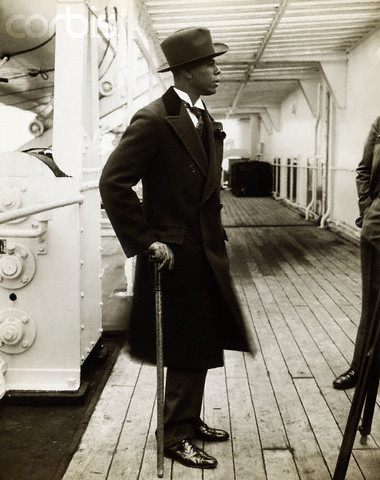 Hubert Julian was born in Port of Spain, Trinidad, in 1897, the son of a cocoa plantation manager. He migrated to Canada in 1914, where he claimed to have learned to pilot an aeroplane and served as a Lieutenant in the Royal Canadian Air Force.
Hubert Julian was born in Port of Spain, Trinidad, in 1897, the son of a cocoa plantation manager. He migrated to Canada in 1914, where he claimed to have learned to pilot an aeroplane and served as a Lieutenant in the Royal Canadian Air Force.
In 1921 he patented the “Airplane Safety Appliance,” a combination parachute and propeller.
Hubert Julian emigrated from Montreal to Harlem in 1921. His first flight above Harlem occurred during the 1922 Universal Negro Improvement Association Convention, when he flew over the parade in a plane decorated with UNIA slogans. That flight led to his appointment as head of the organization’s new Aeronautical Department. He made his first parachute jump on 3rd, September 1922, at an airshow at Curtiss Fieldon Long Island headlined by black pilot Bessie Coleman. Several more jumps followed in the next year, at Curtiss Field and at Hasbrouck Heights, New Jersey. During one jump in New Jersey in June 1923, Julian played “I’m Running Wild” on the saxophone.
Julian’s most famous parachute jumps were into Harlem itself. On 29 April 1923, Julian flew from an airfield in Hasbrouck Heights to Harlem, circled City College, dropping two noise bombs to attract residents’ attention. He then leaped from the plane, dressed in a bright red suit; the wind carried him away from his target, to a vacant lot on 140th Street near Seventh Avenue, to the roof of a tenement at 301 West 140th Street. A large crowd followed him, and, after a police officer charged him with disorderly conduct, they carried Julian to the UNIA’s Liberty Hall. Addressing the crowd, he spoke about aviation, promoted a parachute he had designed, and urged them to support A. I. Hart, a black-owned department store under threat from white competition. On 5 November 1923, Julian again flew to Harlem, planning to parachute into Saint Nicholas Park. On this occasion, wind carried him instead to the police station on West 123rd Street, as a huge crowd followed. After he became stuck between the station and the next building, two officers pulled him into the second floor.
In 1924, Julian shifted his focus from parachuting to piloting aeroplanes and raised funds to buy a seaplane for a transatlantic flight from New York to Liberia. He named the plane Ethiopia I, decorated its tail with the red, black and green colors of the UNIA. On 4 July 1924, a crowd of thousands gathered on the banks of the Harlem River at 139th Street to see Julian depart. His take-off was delayed for several hours when the owners of the plane appeared and declared Julian still owed them $1400. His supporters, with the help of UNIA members, eventually collected the money from the crowd. However, soon after Julian took off, one of the pontoons fell off the plane, and it crashed into Flushing Bay.
Julian twice more attempted to raise money to buy planes for flights across the Atlantic. In 1926, he planned a flight to Liberia with backing from a West Indian subsidiary of Standard Oil, boxer Tiger Flowers, and Elks Lodges, but it never took place. In 1928, Julian sought funds for a plane to make a round trip flight to Paris. This flight had the backing of State Senator A. Spencer Feld, but the response proved disappointing, and Feld abandoned the effort after six months.
Although Julian never succeeded in flying across the Atlantic, his efforts made him an international celebrity, and in 1931 Emperor Haile Selassie invited him to Ethiopia to take part in his coronation ceremonies. Julian impressed the Emperor with his skills as a parachutist, landing within a few feet of his throne during one ceremony, a feat that won him Ethiopian citizenship and a position in the nation’s airforce. However, Julian had less success as a pilot, crashing the Emperor’s favorite plane, after which he quickly returned to Harlem.
In 1931 he was the first flyer of African descent to fly coast to coast in the United States. He was one of several aviators in the 1920s and 1930s who competed in outdoing each other and briefly holding records for longest non-stop flights. In 1931, for example, Julian held the non-stop non-refueling aviation endurance record with a flight of 84 hours and 33 minutes. He flew a number of flights in and between the Americas, Europe, and Africa, surviving several crashes. In between major flights, he toured with a small all-Black flying circus which he headed, called The Five Blackbirds.
During the Italian invasion of Ethiopia in 1935, Julian flew to Ethiopia to aid in the defense of Selassie’s government. He was put in command of the Imperial Ethiopian Air Force, which at the time consisted of 3 planes. Upon his return to the United States, he was temporarily detained at Ellis Island, over the question of his nationality — British or Ethiopian. Later, after getting into a public fist-fight with fellow African-American aviator John C. Robinson, Julian was ordered to leave the country.

Julian also invented some safety devices used in airplanes.
In 1939, Julian was the producer for the motion picture Lying Lips, directed by Oscar Micheaux (with Robert Earl Jones, who plays the detective in this film, is James Earl Jones’ father).
Here’s a clip:
Julian volunteered to fight for Finland in the Finnish-Russian Winter War in 1939 and 1940.He arrived in Finland, but ended up leaving Finland soon without participating in any military activities.
After the United States entered World War II, Julian volunteered to train for combat with the 99th Pursuit Squadron, the famous Tuskegee Airmen. He was remembered as a colorful character who wore a non-regulation Colonel’s uniform, despite not holding that rank in the United States Army Air Forces, and was discharged before graduation.
Hubert Fauntleroy Julian died in the borough of The Bronx, New York City, in February 1983. He is buried at the Calverton National Cemetery in Suffolk County, New York. His passing went largely unnoticed.
According to the historian Carleton Mabee,
“Among those who piloted planes for Father Divine were… Colonel Hubert Julian, a former Garveyite, who was famous for having regularly piloted a plane for Emperor Haile Selassie of Ethiopia. Julian was flamboyant. He made himself conspicuous by doing aerial stunts over Harlem. While unwilling to follow all of Divine’s teachings, Julian nonetheless identified with Divine and gave flying lessons to Divine followers.”
A series of articles entitled “Black Eagle” was serialized in the African-American New York Amsterdam News newspaper c. 1937-38.
In 1965 a biography of Julian entitled Black Eagle was published by The Adventurers Club in London; another biography of the aviator with the same title written by John Peer Nugent was published in 1971 by Stein and Day in New York.
 The 14 November 1974 issue of Jet Magazine briefly mentions Julian, saying he was then 77 years of age, and was making plans to rescue Haile Selassie, then believed to be held prisoner by the new government of Ethiopia.
The 14 November 1974 issue of Jet Magazine briefly mentions Julian, saying he was then 77 years of age, and was making plans to rescue Haile Selassie, then believed to be held prisoner by the new government of Ethiopia.
Via text from source and images from source.
Become a Harlem Insider!
By submitting this form, you are consenting to receive marketing emails from: Harlem World Magazine, 2521 1/2 west 42nd street, Los Angeles, CA, 90008, https://www.harlemworldmagazine.com. You can revoke your consent to receive emails at any time by using the SafeUnsubscribe® link, found at the bottom of every email. Emails are serviced by Constant Contact












